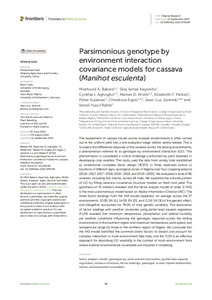| dc.contributor.author | Bakare, M.A. |
| dc.contributor.author | Kayondo, S.I. |
| dc.contributor.author | Aghogho, C.I. |
| dc.contributor.author | Wolfe, M. |
| dc.contributor.author | Parkes, E. |
| dc.contributor.author | Kulakow, P. |
| dc.contributor.author | Egesi, C. |
| dc.contributor.author | Jannink, J. |
| dc.contributor.author | Rabbi, I.Y. |
| dc.date.accessioned | 2023-04-18T08:10:22Z |
| dc.date.available | 2023-04-18T08:10:22Z |
| dc.date.issued | 2022-09-21 |
| dc.identifier.citation | Bakare, M.A., Kayondo, S.I., Aghogho, C.I., Wolfe, M., Parkes, E., Kulakow, P., ... & Rabbi, I.Y. (2022). Parsimonious genotype by environment interaction covariance models for cassava (Manihot esculenta). Frontiers in Plant Science, 13: 978248, 1-18. |
| dc.identifier.issn | 1664-462X |
| dc.identifier.uri | https://hdl.handle.net/20.500.12478/8138 |
| dc.description.abstract | The assessment of cassava clones across multiple environments is often carried out at the uniform yield trial, a late evaluation stage, before variety release. This is to assess the differential response of the varieties across the testing environments, a phenomenon referred to as genotype-by-environment interaction (GEI). This phenomenon is considered a critical challenge confronted by plant breeders in developing crop varieties. This study used the data from variety trials established as randomized complete block design (RCBD) in three replicates across 11 locations in different agro-ecological zones in Nigeria over four cropping seasons (2016–2017, 2017–2018, 2018–2019, and 2019–2020). We evaluated a total of 96 varieties, including five checks, across 48 trials. We exploited the intricate pattern of GEI by fitting variance–covariance structure models on fresh root yield. The goodness-of-fit statistics revealed that the factor analytic model of order 3 (FA3) is the most parsimonious model based on Akaike Information Criterion (AIC). The three-factor loadings from the FA3 model explained, on average across the 27 environments, 53.5% [FA (1)], 14.0% [FA (2)], and 11.5% [FA (3)] of the genetic effect, and altogether accounted for 79.0% of total genetic variability. The association of factor loadings with weather covariates using partial least squares regression (PLSR) revealed that minimum temperature, precipitation and relative humidity are weather conditions influencing the genotypic response across the testing environments in the southern region and maximum temperature, wind speed, and temperature range for those in the northern region of Nigeria. We conclude that the FA3 model identified the common latent factors to dissect and account for complex interaction in multi-environment field trials, and the PLSR is an effective approach for describing GEI variability in the context of multi-environment trials where external environmental covariables are included in modeling. |
| dc.description.sponsorship | Bill & Melinda Gates Foundation |
| dc.description.sponsorship | CGIAR Trust Fund |
| dc.description.sponsorship | Foreign, Commonwealth and Development Office, United Kingdom |
| dc.format.extent | 1-18 |
| dc.language.iso | en |
| dc.subject | Cassava |
| dc.subject | Genotypes |
| dc.subject | Genotype Environment Interaction |
| dc.subject | Food Security |
| dc.subject | Nigeria |
| dc.title | Parsimonious genotype by environment interaction covariance models for cassava (Manihot esculenta) |
| dc.type | Journal Article |
| cg.contributor.crp | Roots, Tubers and Bananas |
| cg.contributor.affiliation | Cornell University |
| cg.contributor.affiliation | International Institute of Tropical Agriculture |
| cg.coverage.region | Africa |
| cg.coverage.region | West Africa |
| cg.coverage.country | Nigeria |
| cg.coverage.hub | Headquarters and Western Africa Hub |
| cg.researchtheme | Biotech and Plant Breeding |
| cg.researchtheme | Plant Production and Health |
| cg.identifier.bibtexciteid | BAKARE:2022a |
| cg.isijournal | ISI Journal |
| cg.authorship.types | CGIAR and advanced research institute |
| cg.iitasubject | Agronomy |
| cg.iitasubject | Cassava |
| cg.iitasubject | Food Security |
| cg.iitasubject | Plant Breeding |
| cg.iitasubject | Plant Production |
| cg.journal | Frontiers in Plant Science |
| cg.notes | Open Access Journal; Published online: 21 Sep 2022 |
| cg.accessibilitystatus | Open Access |
| cg.reviewstatus | Peer Review |
| cg.usagerightslicense | Creative Commons Attribution 4.0 (CC BY 0.0) |
| cg.targetaudience | Scientists |
| cg.identifier.doi | https://dx.doi.org/10.3389/fpls.2022.978248 |
| cg.iitaauthor.identifier | Kayondo Siraj Ismail: 0000-0002-3212-5727 |
| cg.iitaauthor.identifier | E J Parkes: 0000-0003-4063-1483 |
| cg.iitaauthor.identifier | Peter Kulakow: 0000-0002-7574-2645 |
| cg.iitaauthor.identifier | Chiedozie Egesi: 0000-0002-9063-2727 |
| cg.iitaauthor.identifier | Ismail Rabbi: 0000-0001-9966-2941 |
| cg.futureupdate.required | No |
| cg.identifier.issue | 978248 |
| cg.identifier.volume | 13 |

